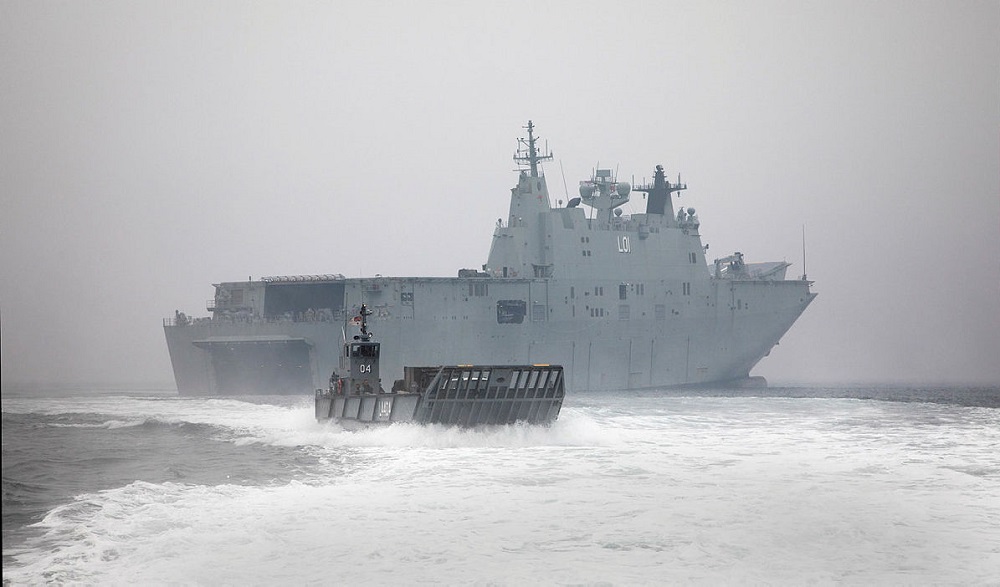
Australia’s political leaders have spoken strongly about assisting our Pacific ‘family’ through the Covid-19 crisis. But the needs of the island nations go far beyond medical supplies and expertise. The Royal Australian Navy could play an important role in supporting critical infrastructure if the crisis hits the islands hard.
Covid-19 infections in the Pacific are starting to ramp up. Australia is already helping with laboratories, medical equipment, health expertise and public information campaigns. But, in addition to the health impact, the crisis has the potential to overwhelm critical infrastructure in the islands.
The Australian Defence Force, including the navy’s two giant landing ships, could be an important, and highly visible, element of Australia’s response. HMAS Adelaide and its sister ship, HMAS Canberra, are the biggest ships in the Royal Australian Navy and have extraordinary capabilities for disaster response—helicopters, landing craft, medical facilities, engineering workshops, supplies and accommodation for large numbers of people.
Over the past few weeks, attention has been given to the use hospital ships for medical assistance, including by Australia. But using ships for this purpose requires careful consideration and preparation.
For years, the US Navy has been deploying its hospital ships in the Pacific and Indian oceans to provide health services to island communities as part of the Pacific Partnership program. USNS Mercy and USNS Comfort are each the size of a large aircraft carrier, with 12 operating theatres, 1,000 beds and large medical teams comprising US military personnel and volunteers. On 30 March, the Comfort arrived in New York Harbor to provide assistance during the Covid-19 crisis; the Mercy has been moored at the Port of Los Angeles since 27 March.
China, too, understands the importance of using hospital ships to project soft power. In response to criticism over its failure to provide significant assistance to the region after the 2004 tsunami, China built its own hospital ship, the Daishan Dao, which has sailed throughout the Indian Ocean, and in Pacific, Caribbean and African waters, providing medical services through its eight operating theatres and 300 beds. Beijing says that, over the past decade, the Daishan Dao has visited some 40 countries and provided healthcare services to more than 180,000 people. The ship’s 2018 tour included visits to Papua New Guinea, Vanuatu, Fiji and Tonga.
In theory, Australia’s landing ships could provide medical assistance through their two operating theatres, eight-bed critical care units, and pathology, radiology, dental and pharmacy services. While these impressive facilities have been used to support military personnel on board, and sometimes Australian personnel ashore, they’ve never been used for regional health outreach.
There are sound reasons for exercising caution in deploying large warships for community health, particularly during a pandemic. Covid-19 outbreaks on two aircraft carriers, France’s Charles de Gaulle and America’s Theodore Roosevelt, have effectively disabled those vessels. The Comfort and Mercy are also now both battling onboard outbreaks of their own.
But while medical assistance is an initial focus of Australia’s regional response to the Covid-19 crisis, it’s highly likely that we will soon move to helping the islands maintain their critical infrastructure, including telecommunications, fuel and electricity.
All of these pieces of critical infrastructure will come under increasing strain because of the absence of workers or the breakdown of the long and tenuous supply lines that the islands depend on. An interruption of fuel or diesel supplies, for example, whether due to local or international factors, would impede the transport of people, food and essential good and the supply of electricity, which is generally powered by diesel generators. Such an event would cause significant disruptions and threaten the social order.
These effects would be greatly magnified by a concurrent natural disaster, as when Cyclone Harold recently hit Vanuatu.
In coming weeks, we could well see ADF engineering teams, based afloat or ashore, helping to maintain critical infrastructure in the region. The Adelaide and the Canberra would be of great value as floating warehouses and bases for engineering services, although their deployment could come with real risks.
Assistance with maintaining infrastructure might be far more significant for vulnerable island nations than medical assistance. Indeed, the French navy recently deployed its landing ship Mistral to the island of Réunion in the Indian Ocean for this purpose.
Australia has been an adept practitioner of defence diplomacy through military training, disaster relief and defence capability programs. We need to help (and, importantly, to be seen to be helping) our Pacific family in this crisis, while also having regard to our own needs. Some of the ADF’s capabilities could be a highly visible component of our response in the region.

